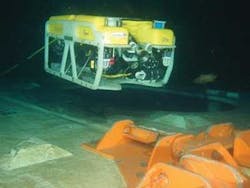In 2007, BP Trinidad and Tobago (bpTT) plans were to produce two new gas fields, Cashima and Mango, to supply gas both to the domestic market and for LNG exports to the US. This required installation and connection of the fields’ subsea pipeline and riser system. In addition, two further pieces of work were needed: connection of the Beachfield Upstream Development (BUD) gas pipeline, operated by Trinidad’s National Gas Company, to bpTT’s greater Cassia central processing hub; and also connection of the new tanker loading oil pipeline, the NOEL (new oil export loading) pipeline, with the Galeota terminal in Southeast Trinidad. BPTT contracted Superior Offshore for the work.
The fields are 50 mi (80 km) offshore Trinidad in water depths of 200 ft to 275 ft (61 m to 84 m). The region has strong currents and unpredictable weather. Throughout the project, Superior personnel worked in 8-ft to 10-ft (2.5-m to 3-m) seas while battling a 1.5-knot loop current. In addition, the project required as much local labor as possible in an area of operation that required a high level of technical expertise. IMCA certification, equipment management, and installation posed logistical challenges.
Superior provided a comprehensive and international solution with a suite of subsea services including construction and fabrication, consolidated facilities, remotely operated vehicles (ROVs), diving services, a safety record, and expanded IMCA certification. Superior deployed its resources to Trinidad. The company brought in qualified marine and subsea construction personnel from around the world. Divers came from the US, the UK, Scotland, South Africa, Trinidad, and Canada — more than 250 IMCA Diving Standard certified experts. Ships’ crews arrived from the US, the UK, Canada, India, and the Philippines. Project personnel came in from the US, Trinidad, Canada, the UK, and South Africa. Special attention was paid to maintaining a high local labor content with riggers, welders, surveyors, administrative, and local logistics coordinators. Prior to the start of the project, Superior was also audited to bpTT’s Safety and Management System.
Superior mobilized a complete project management and engineering team of more than 20 personnel, all working to the client’s HSE standards and IMCA compliance. A total of 13 vessels, including 11 purpose-built marine construction vessels, were deployed. Services included total project management, coordination of local labor, and specialized marine construction services such as saturation diving, surface air diving, and ROV services. The company deployed three ROVs and 23 ROV operators.
For the Trinidad project, Superior’s ROV of choice for the bulk of the subsea work was theSeaeye Lynx ROV, supported by the Mohawk ROV.
Superior completed the project in less than seven months. Spools and risers were installed on Amherstia, Mango, Cashima, and Cassia B (BUD) production installations. Subsea spools were also installed on the NOEL tanker loading pipeline. TheGulmar Condor and the Seamec III handled installation of all the 26-in. (66-cm) and 36-in. (91-cm) spool elements and the Crossmar XIV installed the 30-in. (76-cm) spool elements and a PLEM on NOEL. In addition, the 26-in. riser installation on the Amherstia was completed at depths of more than 275 ft (84 m).
Nature did not cooperate. During the project the schedule was hit by one tropical disturbance, two earthquakes, one regional viral outbreak (that affected 50 personnel), and four office relocations, one necessitated by flooding. Despite these challenges, work was completed within a tight timeframe with a Total Recordable Incident Rate (TRIR) of zero on almost 658,000 man hours.





